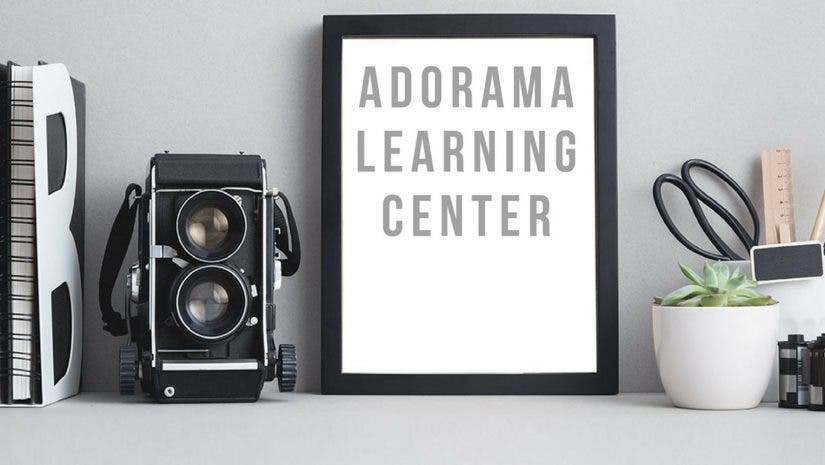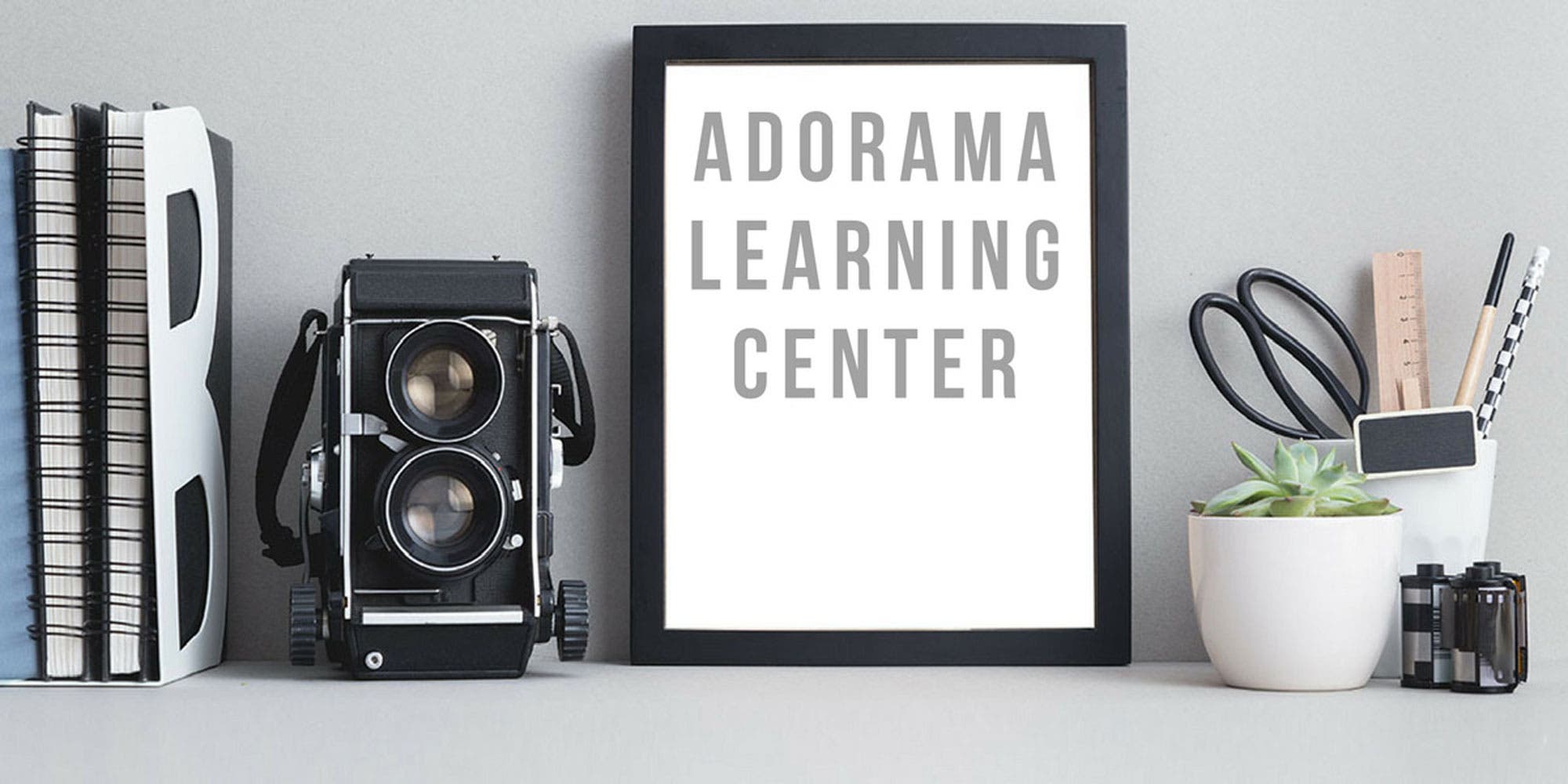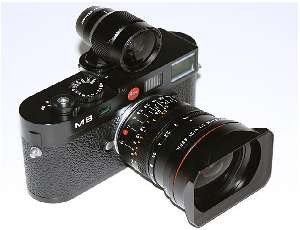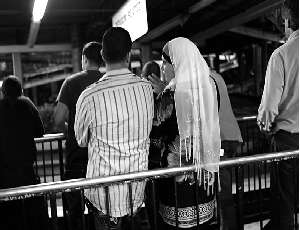UPDATED 4:15 PM, Sept. 9, 2009
Leica today introduced the M9, the world’s first full-framme digital rangefinder camera and the world’s smallest full-frame 35mm-format camera. It accepts all 22 currently made and almost all previously-made Leica M-mount lenses, without cropping the image. The 18 megapixel 35mm LCD sensor was designed exclusively for Leica by Kodak. Remarkably, the new sensor fits in a body that’s identical in dimensions and weight to the M9’s predecessors, the M8 and M8.2. The M8 and M8.2 have been discontinued.
The sensor features a glass cover that suprresses infrared and UV light , a feature that was notably and controversially missing from the M8. Featuring low-refractive micro lenses that are laterally displaced towards the image center to match the optical characteristics of M lenses, the sensor is also intentionally missing a moire filter for optimal resolution. Leica says any moire patters that result will be eliminated by the camera’s on-board software.
Bult on a chassis of die-cast magnesium with solid brass top and bottom plates, the M9’s clear-view rangefinder features the camera’s classic match-image focusing and bright, automatic parallax compensating lens frame lines that change depending on which lens is mounted. The new metal-leaf focal-plane shutter has been dampened to reduce noise, and was noticeably quieter than the M8 shutter.
The Leica M9 is shipping now to stores, and should be available in a matter of days. The body will cost $6,999. Adorama is accepting pre-orders, on a first-come, first-served basis, for the Black or Gray M9 now. and Credit cards will not be charged until the order is shipped.
Key features at a glance:
• Full-frame 18-megapixel 35mm CCD sensor that captures JPEG and DNG-format RAW image files
• Compatible with all M-series Leica lenses
• Extended performance with M-lenses that have six built-in lensmount coding sensors.
• Quiet shutter operation. Shutter is cocked when the photographer lifts finger off shutter release.
• Classic Leica viewfinder with parallax corrected frame edge markings that change as the lens is changed
• ISO range 80-2500. Auto ISO shift available, with ISO range limits. Very low noise claimed.
• Auto exposure bracketing at user-selected numbers and increments; high dynamic range phtoos possible with this function.
• Built-in infrared/UV filter (the lack of such a filter in the M8 was a cause of considerable controversy for Leica), but no Moire filter, which Leica says would cause image deterioration.
• 2.5-inch LCD monitor, 230,000 pixel resolution
• Programable user profiles
• Image preview zoom down to single-pixel level
• Full Adobe Photoshop Lightroom included
For details and full specifications, read the Leica press release:
New: The LEICA M9
Digital photography enters a new dimension.
Leica Camera AG, Solms presents the LEICA M9, the world’s first digital rangefinder camera with a full-format 24 × 36 mm sensor. As the world’s most compact full-format system camera, the M9 extends the legendary heritage of the Leica rangefinder M System and unites over 50 years of continuous technical improvements to the system with the best in cutting-edge digital technology.
The successful combination of an extremely high-resolution image sensor, the superior performance of M lenses and sophisticated processing of the captured digital information ensures the best imaging results in all photographic situations. With its wide-ranging technical specifications, the camera adjusts to all fields of photography – from reportage and ‘available light’ to the capture of discreet and fine-art images alike. The M9 is the ideal tool for all photographers who demand the highest standards in image quality and a freedom of composition.
The 18-megapixel CCD image sensor, specifically designed and developed for the M9, enables the capture of the full 35-mm film format without any compromises. All M lenses mounted on the LEICA M9 therefore offer the same angle of view as with film camera models, meaning the enormous potential performance of the current M lens portfolio with focal lengths from 16 to 135 mm is now fully available in a digital camera for the very first time. In addition, most Leica M lenses built since 1954 can still be used on the new M9. Once again, Leica Camera AG proves their commitment to full system compatibility and the enduring value of the M series.
The sensor of the M9 features a newly developed glass cover that is designed to guarantee the suppression of infrared light in practical photography, avoiding the necessity of mounting special UV/IR filters.
Concentrating on essentials, its simple handling is a significant feature of the Leica M System. In the case of the LEICA M9, the handling has been further improved by simplification of the menu navigation: setting the sensitivity only requires holding down the ISO button while simultaneously turning the dial to select the required setting. All other functions important for everyday situations are quickly and easily accessible by pressing the set button. Furthermore, the menu also offers a snapshot profile option. In this mode, the M9 automatically sets as many settings as possible and provides a valuable aid to spontaneous and discreet photography. The camera also features automatic lens recognition via 6-bit coding. On the basis of the coded information, the M9 can compensate for any system-inherent lens vignetting effects (darkening in the image corners).
Despite the considerably larger sensor, Leica has been successful in making the LEICA M9 body comparable to the compact size typical of M cameras. With its compact dimensions of only 139 × 37 × 80 mm (5.47 × 1.45 × 3.15 in), the LEICA M9 maintains the ideal size of the M series and is now the world’s smallest full-format digital system camera.
As a working tool for professionals and ambitious amateur photographers, all features and functions of the LEICA M9 are designed for absolute dependability and endurance. The one-piece, full-metal housing is made from a high-strength magnesium alloy. Additionally, the top deck and bottom plate are machined from solid brass blocks providing perfect protection for the precious inner mechanisms. The digital components and shutter assembly of the M9 are similarly constructed with extreme endurance in mind. For photographers, this means absolute reliability for decades of use.
The LEICA M9 is now available in two different finishes: a standard version in black and, for the first time, a version finished in steel-grey. The two models also have different finely-structured leather coverings.
The sensor
The CCD sensor specially developed by Kodak for the LEICA M9 has been optimised to fully exploit the particular qualities of the Leica M lens system. As a result, the LEICA M9 achieves highest resolution values that guarantee outstanding image quality.
The image sensor of the M9 employs further-advanced and meticulously designed micro lenses with a low refractive index. The micro lenses at the sensor edges are laterally displaced towards the image center to precisely match the characteristics of M lenses. This optimized micro lens design, based on many years of precision optical engineering experience, captures and concentrates even the most oblique rays on the sensor and reliably prevents image brightness fall-off at the edges and corners of the image. As a result, all existing Leica M lenses maintain their full performance when used for digital photography.
The intentional decision to exclude a moiré filter, which optically filters out the finest image details, was made to permit full the exploitation of the superb resolution of Leica M lenses. Any moiré patterns occurring with the M9 are eliminated in the camera’s digital signal-processing software. The optimized signal–noise ratio of the CCD image sensor reduces the need for digital post-processing and ensures that images possess an unrivaled, natural visual impact. This results in high-contrast, particularly high-resolution exposures with natural color rendition from corner to corner.
The lenses
All Leica M lenses mounted on the LEICA M9 offer the same angle of view as with film camera models. Therefore, for the first time, the immense performance potential of the lenses is now maintained and can be fully exploited for digital photography. In line with Leica’s renowned commitment to extreme system compatibility, most Leica M lenses built since 1954 can be used on the new M9. As a result of the high mechanical and optical precision and extraordinarily good imaging performance, and particularly that of the current range, Leica M lenses are now ideal for use in digital photography. Performance criteria, such as the individual coating of each element, have long been a Leica standard, and there was no need to develop and implement any special measures for ‘digital lenses.’
The efficient image sensor on the M9 demands a particularly high spatial resolution that is, above all, offered by the latest M lenses. The excellent correction of optical aberrations and high resolution make them all the more suitable for digital use. The current M lenses are supplied with a 6-bit code on the bayonet mount that is scanned optically by the M9. On the basis of the coded information, the M9 can compensate for any (almost negligible) system-inherent vignetting effects if necessary. In addition, the lens type is recorded in the EXIF data of the image files and, when using the latest flash units like the LEICA SF 58, automatically adjusts the reflector to match the focal length of the lens attached.
The viewfinder / rangefinder
The Leica viewfinder / rangefinder system sets the LEICA M9 apart from the market-dominating SLR and compact digital cameras and makes it particularly suitable for vibrant reportage photography, ‘available light’ exposures and discreet portraiture. Photographers become part of the action and frame whatever they wish to capture in the viewfinder – a scene, a mood, a moment. Simultaneously, the photographer still perceives what is going on outside the viewfinder frame. The decisive moment can be anticipated, and can therefore be captured at precisely the right instant. This results in particularly authentic images that are not impaired by the presence of the photographer.
The clear view of the subject remains even during exposure and, even in the most adverse lighting conditions, the bright, high-contrast viewfinder guarantees extremely fast and precise focusing. In combination with the minimal delay between releasing the shutter and capturing the shot – in digital photography too – the combined viewfinder / rangefinder system positions Leica M cameras among the fastest cameras in the world.
In contrast to SLR photography, where focusing must take place through the lens and focal length and aperture determine focusing accuracy, the rangefinder base of the Leica M remains precisely the same and independent of the actual lens being used. This is the reason why its focusing precision is immensely superior for shorter focal lengths. The high-contrast, rectangular RF spot in the center of the viewfinder guarantees fast, precise and pin-sharp focusing, even under adverse lighting conditions.
The frame selector lever allows photographers to simulate different compositions with alternative focal lengths and assess the most appropriate lens for the shot without changing lenses. Because their position is automatically adjusted by automatic parallax compensation depending on the focusing distance, the six different bright-line frames always show the precise image framing. The bright-line viewfinder shows all other information relevant to the capture of a perfect image and the peripheral area around the envisaged subject, thus providing ideal conditions for spontaneous and unobtrusive photography.
The shutter
The LEICA M9 features a new, microprocessor-controlled, particularly silent, metal-leaf, focal-plane shutter that enables shutter speeds of up to 1/4000 seconds. This allows the photographer to maintain complete creative freedom by using a selective focus at maximum apertures, even in bright situations. The short flash synchronisation speed of 1/180 seconds enables daylight flash exposures with selective focus.
Together with its compact form, the camera’s virtually silent shutter is another keystone for discreet and unobtrusive photography. Additionally, photographers can select the appropriate moment for re-cocking the shutter. When longer exposure times requiring an extremely steady camera stance are essential, a slight pressure on the shutter release button in ‘soft release’ mode is suf
ficient.Intuitive handling
The LEICA M9 concentrates the photographer’s attention on photographic essentials, not on setting the camera. Particular diligence, many years of experience and a vast knowledge of how professional photographers work have all influenced the handling concept for the digital functions of the LEICA M9. The result is a simple, clearly laid-out and intuitive user interface that concentrates purely on essentials; multifunction buttons and complex menu hierarchies have been avoided.
The key control element is an intuitive four-way switch and dial combination that enables fast menu navigation. Pressing the ‘set’ button activates the capture parameter menu on the 2.5″ monitor screen. The most important image-capture settings are quickly and easily set in this menu: sensor sensitivity, exposure correction, white balance, image-data compression and resolution.
Free profile storage spaces are also available for fast access to frequently used or application-specific combinations.
The menu button is also used for changing more permanent, values outlining basic controls in the clearly structured system menu. The photographer can also choose whether the captured image is displayed immediately for assessment on the large monitor, how long it should be displayed and whether an additional tonal value histogram is shown.
The LEICA M9 has a delayed shutter release function with a choice of two countdown times – 2 and 12 seconds.
The technical features of the LEICA M9 allow it to quickly adapt to its intended use. Its sensitivity ranges from ISO 160 (PULL 80) for wide-open apertures on bright days to ISO 2500. At the same time, very low noise and finely detailed images are achieved throughout the sensitivity range, even at the highest settings. The very low noise characteristics, a bright viewfinder / rangefinder, low-vibration shutter and fast lenses make the M9 the perfect camera for ‘available light’ photography.
Innovative flash technology
The M-TTL flash technology in the LEICA M9 enables both precise and creative control over flash and mixed lighting effects. Prior to the actual exposure, a measuring flash is emitted that is metered through the lens. The flash power is then precisely determined with consideration for the natural lighting conditions, ensuring that natural lighting is maintained as much as possible In combination with the aperture priority exposure mode, the auto-slow sync function ensures subtle lighting of the subject, whereby the longest shutter speed may be set manually or, when using 6-bit coded lenses, automatically, according to the 1/focal length rule of thumb.
Image assessment with the tonal value histogram
As a professional digital camera, the LEICA M9 naturally offers an RGB tonal value histogram, which can be displayed at any time for the assessment of stored images. This feature is also available in conjunction with the automatic image review function. A useful additional aid is the indication of overexposed image areas by means of a so-called ‘clipping warning.’ These two quality control tools are updated for enlarged views and thus allow the quality of even the finest image details to be assessed. Pressing the info function button displays all photographically relevant settings, including additional metadata stored in the image files. These functions enable full control over captured results at the shooting location of the digital images.
Digital workflow
The M9 comes with Adobe Photoshop Lightroom, a professional digital workflow solution for Apple Mac OS X and Microsoft Windows. The software is available as an online download for all LEICA M9 customers. This also ensures that the latest release is always readily available. Adobe Photoshop Lightroom offers a vast range of functions for the management, processing and presentation of digital images, quite independent of image format. If the images from the M9 are saved as raw data in the standardized and future-proof Adobe Digital Negative Format (DNG), Adobe Photoshop Lightroom, with its sophisticated and precise processing options, guarantees direct and extremely high-quality image processing with maximized image quality. The 14-bit-per-channel color information captured by the image sensor is then processed at a16-bit-per-channel color information until the final presentation, and ensures that the most delicate tonal differentiations are preserved in maximum quality after completion of the post-processing sequence.
Materials, finish and dimensions
The tough and resilient top deck and base plate of the M9 are machined from solid brass blocks, while the full-metal body is manufactured from a high-strength magnesium alloy that ensures a long and reliable professional working life. The rechargeable battery and the SD card slot are protected from dust and moisture under the base plate, which uses a specialized locking mechanism effectively preventing unintentional opening and the subsequent loss of the battery and SD card. In addition, this long-established construction concept, already employed for decades in the Leica M System, significantly increases the structural stability of the camera body.
The experienced technicians at the Leica factory in Solms, Germany are responsible for the hand-assembly and hand-calibration of M9 bodies and the precise testing of all mechanical and electrical components. The experience gathered over decades of maintenance and repairs by Leica Customer Service creates a solid foundation for long life and enduring value. Even today, the service department maintains and repairs all M cameras built since 1954.
Sensor cleaning
The LEICA M9 offers a special function for manual sensor cleaning: selecting the appropriate item from the menu and pressing the shutter release locks the shutter open to allow access to the sensor for cleaning purposes. Due to the short register of Leica M cameras, the sensor is easier to access than in DSLR cameras in which the sensors are located behind the mirror box and shutter assembly.
Technical data LEICA M9
Camera type: Compact digital rangefinder system camera
Lens mount: Leica M bayonet with additional sensor for 6-bit coding.
Lens system: Leica M lenses from 16 to 135 mm.
Image format / image sensor: 5270 × 3516 pixels
(18.5 megapixels) CCD chip, active area approx. 23.9 × 35.8 mm / 5212 x 3472 pixels (18 megapixels) (corresponds to the effective image format of Leica M film cameras).
Optional resolution:
DNG™: 5212 × 3472 (18 MP),
JPEG: 5212 × 3472 (18 MP), 3840 × 2592 (10 MP),
2592 ×1728 (4.5 MP), 1728 ×1152 (2 MP),
1280 x 846 pixels (1 MP).
Image file formats:
DNG™ (RAW data), optionally uncompressed or slightly compressed (by non-linearreduction of color depth), 2 JPEG compression levels
File sizes:
DNG™: 18 MB (compressed) 36 MB (uncompressed)
JPEG approx. 2 to 10 MB, (depending on image content)
Colour spaces: Adobe® RGB, sRGB
White balance: Automatic, manual, 7 presets, direct color temperature selection
Storage media: SD cards up to 2 GB / SDHC cards up to 32 GB
Menu languages: German, English, French, Spanish, Italian, Japanese, traditional Chinese, simplified Chinese, Russian
Compatibility: Windows® XP/Vista®; Mac® OS X (10.5)
Exposure metering:
Through-the-lens (TTL) metering, center-weighted at working aperture
Center-weighted TTL metering for flash exposure with dedicated SCA-3000/2 standard flash units
Metering principle: The light reflected from the bright leaves of the first shutter curtain is metered
Metering range (at ISO 160/23°):
At room temperature and normal humidity, equivalent to EV 0 to 20 or f 1.0 and 1.2s to f 32 and 1/1000 s. Flashing left triangular LED in the viewfinder indicates light levels below metering capability
Metering cell for available light (ambient light metering):
Silicon photodiode with condenser lens, bottom center of camera base
Sensitivity range:
ISO 80/19° to ISO 2500/35°, selectable in 1/3 ISO increments, in aperture priority automatic mode A and manual exposure setting, optional automatic control or manual selection, automatic control in snapshot mode
Exposure modes:
Optional automatic determination of shutter speeds with preselected apertures – aperture priority automatic mode A – with corresponding digital display, or manual selection of shutter speed and aperture and balance by means of an LED light balance with correct exposure display, or over exposure / camera shake trend prevention (snapshot mode only)
Flash connection:
Hot shoe with center and control contacts
Synchronisation:
Optional, on first or second curtain
Flash synchronisation speed:
1/180 s; longer shutter speeds may be used
Flash metering:
(With SCA-3501/3502 adapter or SCA-3000-standard flash unit, e.g. LEICA SF 24D / LEICA SF 58) Flash exposure control with center-weighted TTL pre-flash metering
Flash metering cell:
2 silicon photodiodes with condenser lens in camera base
Flash exposure correction:
±3 1/3 EV in 1/3 EV increments, adjustable on SCA-3501/3502 adapter
Settings in computer mode for LEICA SF 24D, ±3 EV in 1/3 EV increments, or from 0 to –3 EV in 1 EV increments / adjustable in all modes for LEICA SF 58, ±3 EV in 1/3 EV increments
Displays in flash mode:
Flash ready:
constant illumination of flash symbol LED in the viewfinder, flash confirmation: Constant illumination or rapid flashing of the LED after exposure, underexposure indicated by temporarily extinguished LED
Viewfinder principle:
Large size, bright, combined bright-line viewfinder / rangefinder with automatic parallax compensation
Eyepiece:
Adjusted to -0.5 dioptres Correction lenses for –3 to +3 dptr. available
Image field framing:
By projection of two bright-line frame with each lens attached: for 35 and 135 mm, or for 28 and 90 mm, or 50 and 75 mm. Automatically displayed when lens mount locks. Any of the pairs of bright-line frames can be displayed by moving the frame selection lever.
Parallax compensation:
The horizontal and vertical differences between the viewfinder and the lens are automatically compensated in accordance with the focusing distance set, i.e. the bright-line frame of the viewfinder automatically moves to cover the image field covered by the respective lens.
Correspondence between the viewfinder and the actual image:
At a focusing distance of 1 meter, the bright-line frame size corresponds precisely to that of a sensor of 23.9 × 35.8 mm. Focused at infinity, and depending on the focal length, approx. 7.3% (28 mm) to 18 % (135 mm) more of the sensor is covered than the bright-line frame actually shows, the opposite is the case for focusing distances less than 1 meter, i.e. somewhat less.
Viewfinder magnification(for all lenses): 0.68×
Long-base rangefinder:
Bright rectangular spot (RF spot) with coincident and superimposed rangefinder in the center of the viewfinder
Effective rangefinder base:
47.1 mm (actual base length 69.25 mm × viewfinder magnification 0.68×)
Viewfinder displays:
(Lower edge) LED symbol for flash status; four-digit, seven-segment digital LED display with dots above and below, display brightness adjusted for ambient light, for exposure correction warnings, display of automatically determined shutter speed in aperture priority automatic mode, exposure value lock indicator, out of metering range warning in aperture priority automatic mode and countdown display for shutter speeds longer than 2 s.
LED light balance with two triangular and one round, central LED in manual exposure mode. The triangular LEDs show the required directions for turning the aperture ring or the shutter speed dial to correct the exposure setting. They also warn of light levels that are above or below the metering range.
Displays on the back: 2.5″ monitor (colour TFT-LCD) with 230,000 pixels
Shutter: Microprocessor-controlled, particularly low-noise, metal-leaf, vertical focal-plane shutter
Shutter speeds: In aperture priority automatic mode (A) continuous from 32 s to 1/4000 s. in manual mode, 8 s to 1/4000 s in half increments, B for arbitrary long exposure times (in conjunction with delayed release T function, i.e. 1st release = shutter opens, 2nd release = shutter closes, (1/180 s) fastest shutter speed for flash synchronization
Shutter cocking:
With integrated motor, with low-noise footprint, optionally only after release of shutter release button.
Continuous shooting: Approx. 2 frames/s, ≥ 8 frames in sequence
Shutter release:
Three steps: activation of metering – store metering values (in aperture priority automatic mode) – shutter release. Standard internal threading for remote release.
Delayed release:
Countdown 2 s (in aperture priority automatic mode and manual exposure mode) or 12 s, menu setting option, countdown is indicated by a flashing LED on the front of the camera and a corresponding display on the monitor screen.
Camera power on / power off:
Main switch located on the top deck, optional sleep mode for camera electronics after 2 / 5 / 10 minutes, reactivation by slight pressure to shutter release button.
Power supply:
1 rechargeable lithium-ion battery, nominal voltage 3.7 V, capacity 1900 mAh. Charge level displayed on monitor screen, when shutter locked in open position (for sensor cleaning), additional acoustic warning signal for insufficient charge
Battery charger:
Inputs: 100–240 V AC , 50/60 Hz, automatic adaptation, or 12/24 V DC
Output: 4.2 V DC, 800 mA.
Camera body:
Full-metal body in diecast magnesium alloy with cataphoretic paint finish and artificial leather trim; Brass top deck and base plate, black or steel-grey finish
Frame selection lever:
Enables the manual display of different bright-line frame pairs at any time (e.g. for framing comparisons)
Tripod thread: A 1/4 (1/4 “) DIN, stainless steel, integrated in base plate
Operating conditions: 0 to +40°C
Interface: 5-pin Mini-USB 2.0 high-speed socket for fast data transfer
Dimensions (length × depth × height):
Approx. 5.47 × 1.45 × 3.15 in
Weight: 20.6 oz (including battery)
Package includes:
Battery charger 100–240 V with two power cords (Euro, USA, may differ for other export markets) and one car charging cable, lithium-ion battery, USB cable, carrying strap






